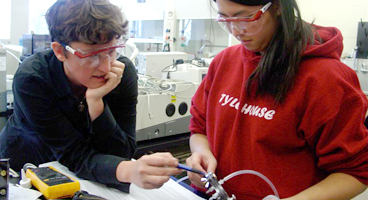Document Type
Article
Publication Date
10-3-2007
Publication Title
Journal of the Acoustical Society of America
Abstract
Direct acoustic stimulation of the cochlea by the sound-pressure difference between the oval and round windows (called the "acoustic route") has been thought to contribute to hearing in some pathological conditions, along with the normally dominant "ossicular route." To determine the efficacy of this acoustic route and its constituent mechanisms in human ears, sound pressures were measured at three locations in cadaveric temporal bones [with intact and perforated tympanic membranes (TMs)]: (1) in the external ear canal lateral to the TM, PTM; (2) in the tympanic cavity lateral to the oval window, POW; and (3) near the round window, PRW. Sound transmission via the acoustic route is described by two concatenated processes: (1) coupling of sound pressure from ear canal to middle-ear cavity, H PCAV ≡ PCAV PTM, where PCAV represents the middle-ear cavity pressure, and (2) sound-pressure difference between the windows, HWPD ≡ (POW - PRW) PCAV. Results show that: H PCAV depends on perforation size but not perforation location; HWPD depends on neither perforation size nor location. The results (1) provide a description of the window pressures based on measurements, (2) refute the common otological view that TM perforation location affects the "relative phase of the pressures at the oval and round windows," and (3) show with an intact ossicular chain that acoustic-route transmission is substantially below ossicular-route transmission except for low frequencies with large perforations. Thus, hearing loss from TM perforations results primarily from reduction in sound coupling via the ossicular route. Some features of the frequency dependence of H PCAV and HWPD can be interpreted in terms of a structure-based lumped-element acoustic model of the perforation and middle-ear cavities.
Volume
122
Issue
4
First Page
2135
Last Page
2153
DOI
10.1121/1.2769617
ISSN
00014966
Recommended Citation
Voss, Susan E.; Rosowski, John J.; Merchant, Saumil N.; and Peake, William T., "Non-Ossicular Signal Transmission in Human Middle Ears: Experimental Assessment of the "Acoustic Route" with Perforated Tympanic Membranes" (2007). Engineering: Faculty Publications, Smith College, Northampton, MA.
https://scholarworks.smith.edu/egr_facpubs/71


Comments
Peer reviewed accepted manuscript.